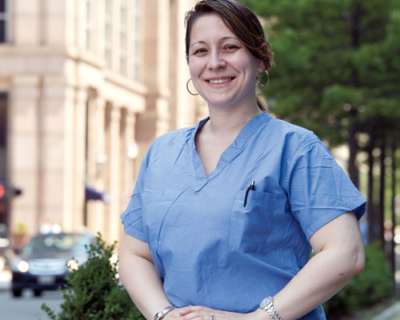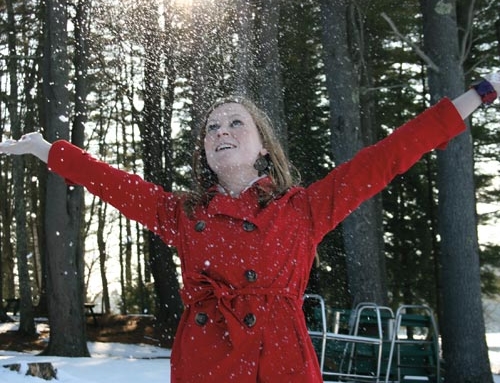 It’s 8 a.m., and more than a thousand volunteers are preparing for the 117th Boston Marathon. Nicole Ashton Rice sits with a group of other volunteers for a training video that outlines what they can expect to happen that day. It’s her eighth year working as a volunteer nurse at the marathon.
It’s 8 a.m., and more than a thousand volunteers are preparing for the 117th Boston Marathon. Nicole Ashton Rice sits with a group of other volunteers for a training video that outlines what they can expect to happen that day. It’s her eighth year working as a volunteer nurse at the marathon.
“The video demonstrates what that day may bring,” Rice says. “It builds upon experiences from previous marathons, because every year is different.”
Thinking about her time as a volunteer nurse at the iconic, international, 26.2-mile race, she remembers one of those particular instances that didn’t always occur. “A man crossed the finish line with active chest pain, going into cardiac arrest.” As an acute care nurse at Boston Medical Center, and with 15 years of experience, her skills are valuable in situations that need that kind of urgent care. At the marathon, “many doctors may not come from an acute care center. They turn to me for my knowledge and ask what I think.” In the case of the runner going into cardiac arrest, “We got him out right away.”
In just a matter of hours, Rice will draw from every medical experience she’s had and the years of training she’s received. Her life, and those of 1,300 medical personnel and 23,000 runners, will forever change in the course of 13 seconds.
10:30 a.m.
“I’ve always had this fascination to go and watch the marathon,” says Rice. “Once I became a nurse, I wanted to be a part of it as a volunteer. It was a dream of mine to be in the medical tent right after the finish line.”
In her first years as a medical volunteer at the marathon, she was stationed in Medical Tent B on Berkley Street, two blocks from the finish line. But she wanted to be closer, providing care and celebrating with the runners. “I wanted to share their accomplishments with them.”
Now in Medical Tent A on Dartmouth Street, the medical area closest to the finish line, Rice joins other volunteers at 10:30 a.m. to prepare their stations. “We have to set up everything – from the ground up. There are 18 sections in the tent, and each section has six cots and three to four nurses.” This year, Rice served in a leadership role for her group.
Just a few hundred feet from the finish line, she sees runners as they complete the marathon. “Once they cross the finish line, they come in, we determine what needs addressing and assess their vital signs.” Doctors of all kinds, including physical therapists and podiatrists, are there to tend to specific issues.
After so many marathons, the medical tents have become fine-tuned machines, delivering personal and immediate attention to runners. “The way it’s set up is so calculated.” Amid the buzz of assessing and delivering medical care, two televisions are set up in the middle of the tent. “There was so much background noise; that was a calming place before the blasts.”
2:49 p.m.
It’s almost six hours since the first runners left the starting point in Hopkinton, Mass., and 5,700 runners have yet to cross the finish line in front of the Boston Public Library on Boylston Street. Rice is performing the volunteer job she’s dedicated herself to for nearly a decade, coordinating and providing medical treatment to runners of the Boston Marathon. She’s with her group of fellow volunteers, all members of the Massachusetts Association of Registered Nurses (MARN), near the entrance of the medical tent.
At 11 minutes to three, a pressure cooker bomb detonates just feet from the finish line. Thirteen seconds later, a second bomb explodes at 755 Boylston, between Exeter and Fairchild streets.
“As [the first bomb] went off, my group was right in the front of the tent, where sections two and 18 are located,” she says. “I knew what it was. My cell phone started going off, but I threw it into my bag.
“When the second one went off, runners already in the tent grabbed their IV bags and literally took off out the back. ”
According to the Boston Athletic Association, which coordinates the marathon, they had 110 volunteers working as members of the Sweep Team. There to provide wheelchairs to tired or injured runners at the finish line, they now play another, even more vital role. “They started bringing injured civilians into the tent,” Rice says. What most of us could only experience in an intangible form, she experienced firsthand. “I saw every single image you saw on TV.”
In the middle of the medical tent, near the televisions streaming scenes from the race and now the aftermath, John Anderson, a medical coordinator, announces through a speaker system, “Everyone, stay calm and keep taking care of the runners,” an order Rice upholds.
Jeff Bauman, the marathon spectator seen in news reports across the world with his legs severely damaged below the knees, receives attention from Rice. “I was helping to raise the leg and run him to the back, to the ambulance.”
Tragically, she also sees those the public has come to memorialize. “The boy and the women [Martin Richard, Krystle Campbell and Lingzi Lu] came through the tent to get to the ambulances.”
And then there are the details only someone close to the scene can relay. “People were hit by shrapnel, but sometimes without blood. There were just little holes from where the shrapnel hit, but no blood.”
As victims come into the tent, she assists EMTs in their effort to categorize injuries. “They ran around to determine the level of care people needed with coded tags: one, two and three. One was getting the person right out of there; three was the last to go.”
The volunteers respond to each patient in the most fluid and organized manner they can. Know-how, materials and space are valuable resources.
“Those who weren’t too hurt were crammed three-to-four inside the ambulance. And we used everything as tourniquets, like belts and shirts. One patient needed CPR, but I was too short to straddle the stretcher to do so.”
4:30 p.m.
Almost two hours since the blasts, the tally of victims nears 264. Police enter the tent where Rice has been applying the skills she learned as a nursing student at Emmanuel College and later as an MSN student with an education focus at Saint Joseph’s College Online. The police announce that the area is now a crime scene, and everyone must leave. The time is 4:30 p.m.
“When I got home,” she says, “I had no idea of the magnitude of what had happened. I was glued to the TV.”
Today Rice says she “wears the hat of a community nurse.” In acute medical care, she commonly works with a team of nurses and doctors and with numerous patients. In addition to her work at Boston Medical Center, MARN and Boston Health Care for the Homeless, she’s a nursing instructor at Simmons College and Massachusetts General Hospital’s Institute of Health Professionals. In a life dedicated to helping others, she’s quick to empathize with their situations.
“Initially, I felt a sense of guilt for bringing my group of nurses into this,” she says about those who worked with her in Medical Tent A. “But this was something way beyond what I brought them into. We were there to care for everyone who came in.”
In a field where the focus is on the patients, Rice also appreciates the other perspective. Since the blasts, “I have a greater appreciation for the word teamwork. There’s a great sense of community with the group of nurses I volunteered with. And they are so thankful for being able to volunteer again.”
And that brings her to a point where one day she’ll have to make a decision: Will she volunteer at the Boston Marathon again?
“I have really struggled to come to grips to do this again. There’s a sense of loss. Maybe, in time.”
Continuing On
At a recent debriefing for first responders at the Westin Copley Place Hotel, Rice had a brief encounter with the memory of her experience at the marathon. “I got off the train at Back Bay Station, got to the corner and stopped in my tracks. I said, ‘Oh my God, that’s where it happened.’ But there was no tent, and I ran inside the hotel.”
And that’s just part of the wave of emotions she’s been riding ever since 2:49 p.m., April 15, 2013. Perhaps because this was so out of the ordinary, Rice appeared to look for everyday life just a day later. “I went to teach my leadership and management nursing course on Tuesday, but they had canceled class to hold a counseling session instead.”
As the city – and the world – reacted to the attack, Rice found herself in the eerie ripple of Monday’s event. So, she took some time off because she “went back to work too quickly.”
At the interfaith prayer service on Thursday, April 18, at the Cathedral of the Holy Cross in Boston, there were so many people attending that she didn’t think she’d get in. But she “had an overwhelming feeling of needing to be there.”
Standing among the crowd outside, her phone rang. It was Sarah, a community preceptor when Rice attended Emmanuel and marathon volunteer. Sarah was with a group of other marathon volunteers, and they were crossing the street toward the church.
“I grabbed my husband and said, ‘Let’s go!’ Once inside the church, City Year volunteers separated the marathon volunteers from the public.”
Wearing their distinctive Boston Marathon white volunteer jackets with blue stripes on the sleeves, they all lined up. President Obama, who spoke at the prayer service, began greeting the volunteers. “When he came up to me, he first looked at my ID that has my name on it. Then, he looked at me and said, ‘Thank you.’
“There are no words to express what it’s like to be thanked by the president. But it meant just as much being there with the group of nurses from that day. I’ve been a nurse for 15 years, and this experience solidified why I made that choice.”
by David Svenson
